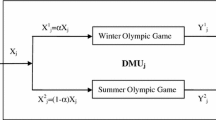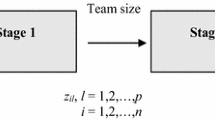Abstract
The Sydney 2000 Olympic Games, held from 15 September through 1 October, were a complete success and confirmed the Summer Olympic games as the most important and popular sport event in the world. More than 10000 athletes from 200 countries participated. Millions of visitors were attracted to the host country and billions of people watched the games on television all over the world.
Access this chapter
Tax calculation will be finalised at checkout
Purchases are for personal use only
Preview
Unable to display preview. Download preview PDF.
Similar content being viewed by others
References
Grimes A, Kelly W and Rubin P (1974). A socioeconomic model of national Olympic performance. Social Sci Q 55: 777–783.
Kiviaho P and Makela P (1978). Olympic success: a sum of non-material and material factors. Int Rev Sport Sociol 2: 5–17.
Condon EM, Golden BL and Wasil EA (1999). Predicting the success of nations at the Summer Olympics using neural networks. Comp Opns Res 26: 1243–1265.
Charnes A, Cooper WW and Rhodes E (1978). Measuring the efficiency of decision making units. Eur J Opl Res 2: 429–444.
Banker RD, Charnes A and Cooper WW (1984). Some models for estimating technical and scales inefficiencies in data envel opment analysis. Mngt Sci 30: 1078–1092.
Cooper WW, Seiford LM and Tone K (2000). Data Envelop ment Analysis. Kluwer: Boston.
Thompson RG, Singleton FD, Thrall RM and Smith BA (1986). Comparative site evaluations for locating a high-energy physics laboratory in Texas. Interfaces 16(6): 35–49.
Podinovski VV and Athanassopoulos AD (1998). Assessing the relative efficiency of decision making units using DEA models with weights restrictions. J Opl Res Soc 49: 500–508.
Banker RD and Morey R (1986). Efficiency analysis for exogenously fixed inputs and outputs. Opns Res 34: 513–521.
Mancebon MJ and Mar Molinero C (2000). Performance in primary schools. J Opl Res Soc 51: 843–854.
Beasley JE (1995). Determining teaching and research efficien cies. J Opl Res Soc 46: 441–452.
Sarrico CS and Dyson RG (2000). Using DEA for planning in UK universi-ties—an institutional perspective. J Opl Res Soc 51: 789–800
Harris II J, Ozgen H and Ozcan Y (2000). Do mergers enhance the performance of hospital efficiency? J Opl Res Soc 51: 801–811.
Bates JM, Baines D and Whynes DK (1996). Measuring the efficiency of prescribing by general practitioners. J Opl Res Soc 47: 1443–1451
Thanassoulis E, Dyson RG and Foster MJ (1987). Relative efficiency assessments using data envelopment analysis: an application to data on rates departments. J Opl Res Soc 38: 397–411.
Pastor JM, Perez F and Quesada J (1997). Efficiency analysis in banking firms: an international comparison. Eur J Opl Res 98: 395–407.
Thanassoulis E (1999). Data envelopment analysis and its use in banking. Interfaces 29(3): 1–13.
Murthi BPS, Choi YK and Desai P (1997). Efficiency of mutual funds and portfolio performance measurement: a non-para metric approach. Eur J Opl Res 98: 408–418.
Miliotis PA (1992). Data envelopment analysis applied to electricity distribution districts. J Opl Res Soc 43: 549–555.
Adolphson DL, Cornia GC and Walters LC (1989). Railroad property valuation using data envelopment analysis. Interfaces 19(3): 18–26.
Sarkis J (2000). An analysis of the operational efficiency of major airports in the United States. J Opns Mngt 18: 335–351.
Good DH, Röller LH and Sickles RC (1995). Airline efficiency differences between Europe and the US: implications for the pace of EC integration and domestic regulation. Eur J Opl Res 80: 508–518.
Athanassopoulos AD and Ballantine JA (1995). Ratio and frontier analysis for assessing corporate performance: evidence from the grocery industry in the UK. J Opl Res Soc 46: 427–440.
Banker RD and Morey RC (1993). Integrated system design and operational decisions for service sector outlets. J Opns Mngt 11: 81–98.
Doyle JR and Green RH (1991). Comparing products using data envelopment analysis. Omega 19: 631–638.
Papagapiou A, Mingers J and Thanassoulis E (1997). Would you buy a used car with DEA? OR Insight 19: 13–19.
Weber CA and Desai A (1996). Determination of paths to vendor market efficiency using parallel coordinates representa tion: a negotiation tool for buyers. Eur J Opl Res 90: 142–155.
Chang YL, Sueyoshi T and Sullivan RS (1996). Ranking dispatching rules by data envelopment analysis in a job shop environment. IIE Trans 28: 631–642
Metters R and Vargas V (1999). A comparison of production scheduling policies on costs, service level and schedule changes. Prod Opns Mngt 8: 76–91.
Clarke SR (2000). Home advantage in the Olympic Games. In: Cohen GL and Langtry TN (eds) Proceedings of the 5th Australian Conference on Mathematics and Computers in Sport. University of Technology Sydney, Australia, pp 76–85.
Editor information
Editors and Affiliations
Copyright information
© 2015 Operational Research Society
About this chapter
Cite this chapter
Lozano, S., Villa, G., Guerrero, F., Cortés, P. (2015). Measuring the Performance of Nations at The Summer Olympics Using Data Envelopment Analysis. In: Wright, M. (eds) Operational Research Applied to Sports. OR Essentials. Palgrave Macmillan, London. https://doi.org/10.1057/9781137534675_10
Download citation
DOI: https://doi.org/10.1057/9781137534675_10
Publisher Name: Palgrave Macmillan, London
Print ISBN: 978-1-349-56807-9
Online ISBN: 978-1-137-53467-5
eBook Packages: Palgrave Business & Management CollectionBusiness and Management (R0)




